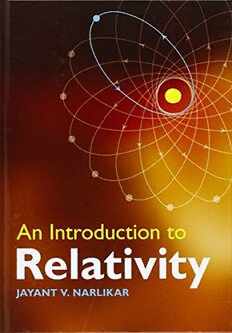
An introduction to relativity PDF
Preview An introduction to relativity
AnIntroductiontoRelativity General relativity is now an essential part of undergraduate and graduate coursesinphysics,astrophysicsandappliedmathematics.Thissimple,user- friendlyintroductiontorelativityisidealforafirstcourseinthesubject. Thetextbookbeginswithacomprehensive,butsimple,reviewofspecial relativity,creatingaframeworkfromwhichtolaunchtheideasofgeneral relativity.Afterdescribingthebasictheory,itmovesontodescribeimportant applicationstoastrophysics,black-holephysics,andcosmology. Severalworkedexamples,andnumerousfiguresandimages,helpstu- dents appreciate the underlying concepts. There are also 180 exercises, whichtestanddevelopstudents’understandingofthesubject. The textbook presents all the necessary information and discus- sion for an elementary approach to relativity. Password-protected solu- tions to the exercises are available to instructors at www.cambridge.org/ 9780521735612. JAYANTV. NARLIKARisEmeritusProfessorattheInter-UniversityCentre forAstronomyandAstrophysics,Pune,India.HeisauthorofAnIntroduc- tion to Cosmology, now in its third edition (Cambridge University Press, 2002),andhasbeenactiveinteachingandresearchingcosmology,theoret- icalastrophysics,gravitationandrelativityfornearlyfivedecades. An Introduction to Relativity Jayant V. Narlikar Inter-UniversityCentrefor AstronomyandAstrophysics Pune,India CAMBRIDGE UNIVERSITY PRESS Cambridge,NewYork,Melbourne,Madrid,CapeTown,Singapore,Sa˜oPaulo,Delhi, Dubai,Tokyo CambridgeUniversityPress TheEdinburghBuilding,CambridgeCB28RU,UK PublishedintheUnitedStatesofAmericabyCambridgeUniversityPress,NewYork www.cambridge.org Informationonthistitle:www.cambridge.org/9780521735612 (cid:1)C J.Narlikar2010 Thispublicationisincopyright.Subjecttostatutoryexception andtotheprovisionsofrelevantcollectivelicensingagreements, noreproductionofanypartmaytakeplacewithoutthewritten permissionofCambridgeUniversityPress. Firstpublished2010 PrintedintheUnitedKingdomattheUniversityPress,Cambridge AcatalogrecordforthispublicationisavailablefromtheBritishLibrary LibraryofCongressCataloginginPublicationdata Narlikar,JayantVishnu,1938– Anintroductiontorelativity/JayantV.Narlikar. p. cm. Includesbibliographicalreferencesandindex. ISBN978-0-521-51497-2(hardback) 1.Generalrelativity(Physics) I.Title. QC173.6.N369 2010 530.11–dc22 2009035288 ISBN9780521514972Hardback ISBN9780521735612Paperback Additionalresourcesforthispublicationatwww.cambridge.org/9780521735612 CambridgeUniversityPresshasnoresponsibilityforthepersistenceor accuracyofURLsforexternalorthird-partyInternetwebsitesreferredto inthispublication,anddoesnotguaranteethatanycontentonsuch websitesis,orwillremain,accurateorappropriate. Contents Preface vii 1 Thespecialtheoryofrelativity 1 2 Fromthespecialtothegeneraltheoryofrelativity 34 3 Vectorsandtensors 41 4 Covariantdifferentiation 59 5 Curvatureofspacetime 70 6 Spacetimesymmetries 85 7 Physicsincurvedspacetime 100 8 Einstein’sequations 116 9 TheSchwarzschildsolution 126 10 Experimentaltestsofgeneralrelativity 143 11 Gravitationalradiation 162 12 Relativisticastrophysics 176 13 Blackholes 194 14 TheexpandingUniverse 223 15 Friedmannmodels 245 16 TheearlyUniverse 275 17 Observationalcosmology 306 18 Beyondrelativity 334 References 353 Index 358 v Preface In1978Iwroteanintroductorytextbookongeneralrelativityandcos- mology, based on my lectures delivered to university audiences. The bookwaswellreceivedandhadbeeninuseforabout15–20yearsuntil it went out of print. The present book has been written in response to requestsfromstudentsaswellasteachersofrelativitywhohavemissed theearliertext. AnIntroductiontoRelativityisthereforeafreshrewriteofthe1978 text,updatedandperhapsalittleenlarged.AsIdidfortheearliertext,I haveadoptedasimplestyle,keepinginviewamathematicsorphysics undergraduateastheprospectivereader.ThetopicscoveredarewhatI considerasessentialfeaturesofthetheoryofrelativitythatabeginner oughttoknow.Amoreadvancedtextwouldbemoreexhaustive.Ihave come across texts whose formal and rigorous style or enormous size have been off-putting to a student wishing to know the A, B, C of the subject. Thus I offer no apology to a critic who may find the book lacking in some of his/her favourite topics. I am sure the readers of this book willbeinapositiontoreadandappreciatethosetopicsaftertheyhave completedthispreliminaryintroduction. CambridgeUniversityPresspublishedmybookAnIntroductionto Cosmology, which was written with a similar view and has been well received. Although the present book contains chapters on cosmology, theyarenecessarilybriefandhighlighttheroleofgeneralrelativity.The readermayfinditusefultotreatthecosmologyvolumeasacompanion volume. Indeed, in a few places in this text he/she is directed to this companionvolumeforfurtherdetails. It is a pleasure to acknowledge the encouragement received from SimonMittonforwritingthisbook.IalsothankVinceHiggs,Lindsay Barnes,LauraClarkandtheircolleaguesatCambridgeUniversityPress fortheiradviceandassistanceinpreparingthemanuscriptforpublica- tion. Help received from my colleagues in Pune, Prem Kumar for fig- ures, Samir Dhurde and Arvind Paranjpye for images and Vyankatesh vii viii Preface Samak for the typescript, has been invaluable. I do hope that teach- ers and students of relativity will appreciate this rather unpretentious offering! JayantV.Narlikar IUCAA,Pune,India Chapter 1 The special theory of relativity 1.1 Historical background 1905isoftendescribedasEinstein’sannusmirabilis:awonderfulyear inwhichhecameupwiththreeremarkableideas.TheseweretheBrow- nianmotioninfluids,thephotoelectriceffectandthespecialtheoryof relativity.Eachofthesewasofabasicnatureandalsohadawideimpact onphysics.Inthischapterwewillbeconcernedwithspecialrelativity, whichwasarguablythemostfundamentaloftheabovethreeideas. It is perhaps a remarkable circumstance that, ever since the initia- tionofmodernsciencewiththeworksofGalileo,KeplerandNewton, therehasemergedafeelingtowardstheendofeachcenturythattheend of physics is near: that is,most in-depth fundamental discoveries have been made and only detailed ‘scratching at the surface’ remains. This feelingemergedtowardstheendoftheeighteenthcentury,whenNewto- nianlawsofmotionandgravitation,thestudiesinopticsandacoustics, etc.hadprovidedexplanationsofmostobservedphenomena.Thenine- teenthcenturysawthedevelopmentofthermodynamics,thegrowthin understandingofelectrodynamics,wavemotion,etc.,noneofwhichhad been expected in the previous century. So the feeling again grew that theendofphysicswasnigh.Asweknow,thetwentiethcenturysawthe emergence of two theories, fundamental but totally unexpected by the stalwartsofthenineteenthcentury,viz.,relativityandquantumtheory. Finally, the success of the attempt to unify electromagnetism with the weakinteractionledmanytwentieth-centuryphysiciststoannouncethat theendofphysicswasnotfaroff.Thathopehasnotmaterializedeven thoughthetwenty-firstcenturyhasbegun. 1
